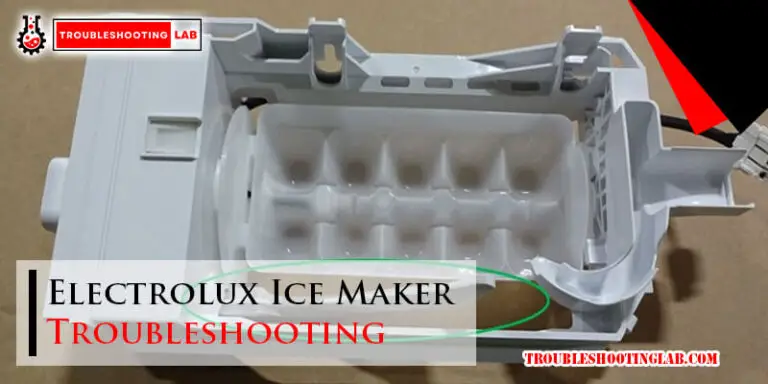Whirlpool Dishwasher Circulation Pump Troubleshooting: Expert Tips
Is your Whirlpool dishwasher acting up and leaving you with a sink full of dirty dishes? If you suspect the circulation pump might be the culprit, you’re not alone.
The circulation pump plays a vital role in ensuring your dishwasher sprays water effectively to clean your dishes. When it’s not working right, your dishwasher can’t do its job properly—and that’s frustrating. But here’s the good news: troubleshooting your Whirlpool dishwasher’s circulation pump doesn’t have to be overwhelming.
With a little guidance, you can identify the issue and decide whether it’s a quick fix or time to call in a pro. In this guide, we’ll walk you through the common signs of a faulty pump, how to diagnose the problem, and what steps you can take to get your dishwasher back in action. If you’re ready to save time, money, and stress, keep reading—you’ll be glad you did.
Common Issues With Circulation Pumps
When your Whirlpool dishwasher isn’t performing as it should, the circulation pump is often a common culprit. This pump is responsible for pushing water through the spray arms to clean your dishes effectively. Understanding the issues that can arise with this component will help you troubleshoot and possibly fix the problem without calling a technician.
Signs Of A Malfunctioning Pump
Wondering if your circulation pump is the issue? A few telltale signs can help you identify the problem. If your dishes come out dirty even after a full cycle, the pump might not be pushing water properly.
Another clue is if your dishwasher cycle takes longer than usual. A faulty pump can disrupt the water flow, causing delays. Do you notice standing water at the bottom of your dishwasher? That’s another red flag pointing to pump trouble.
Noisy Operation Problems
A healthy circulation pump works quietly in the background. If you’re hearing loud grinding or buzzing noises during the cycle, it’s likely that the pump is struggling. This could be caused by a clogged impeller or a damaged motor.
Check for debris like food particles or broken glass that might have entered the pump. Cleaning it out can sometimes resolve the noise. If the sound persists, you may need to replace the pump to restore your dishwasher’s quiet operation.
Water Not Circulating Properly
Is water pooling at the bottom of your dishwasher after each cycle? That’s a clear sign that the circulation pump isn’t working as it should. Without proper water movement, your dishes won’t get cleaned effectively.
Inspect the spray arms to ensure they’re not blocked. If the arms are fine, the issue likely lies with the pump itself. Before replacing the pump, double-check for any visible blockages in the filter or hoses that could be restricting water flow.
Have you ever fixed a circulation pump issue yourself? It’s satisfying to solve the problem and see your dishwasher working like new. If you’re unsure, though, don’t hesitate to consult a professional to avoid causing further damage.
Tools And Preparations
Proper tools and preparations are essential for troubleshooting a Whirlpool dishwasher circulation pump. This ensures the process is smooth and safe, while helping you diagnose issues effectively. Before starting, it’s important to gather the right tools and follow safety precautions. Knowing the pump’s location will save time and effort during the repair.
Safety Precautions To Follow
Disconnect the dishwasher from power to avoid electrical shocks. Turn off the water supply to prevent leaks or spills. Wear protective gloves to avoid cuts or injuries while handling sharp components. Ensure the workspace is clean and free of clutter for better mobility.
Essential Tools For The Job
Use a Phillips screwdriver to remove screws securing the pump. Have a flathead screwdriver for prying components carefully. A multimeter is helpful to test electrical connections. Needle-nose pliers are useful for gripping and removing small parts. Keep a flashlight handy to inspect hard-to-see areas inside the dishwasher.
Identifying The Pump Location
The circulation pump is usually located at the bottom of the dishwasher. Remove the lower dish rack for easier access to the pump area. Inspect the base panel and unscrew it to reveal the pump assembly. Check your model’s user manual for specific pump location details.
Steps To Diagnose The Problem
When your Whirlpool dishwasher isn’t cleaning as it should, the circulation pump might be the culprit. Diagnosing the issue doesn’t require you to be a professional technician. With the right steps, you can pinpoint the problem and decide whether it’s something you can fix or if you need expert help.
Inspecting For Visible Damage
Start by unplugging your dishwasher for safety. Once the power is off, remove the lower panel to access the circulation pump. Look for cracks, leaks, or any other physical damage on the pump or its components.
Check the pump impeller for wear and tear. A damaged impeller can reduce water pressure, affecting cleaning performance. If you see broken parts or water pooling around the pump, it’s likely time for a replacement.
Checking For Blockages
Food debris and grease can clog the circulation pump, reducing its efficiency. Remove the pump cover carefully and inspect for stuck particles. Even something as small as a piece of plastic wrap can cause trouble.
Use a flashlight to check the pump inlet and outlet for obstructions. A clogged hose or filter can also mimic pump problems. Cleaning these areas might restore your dishwasher’s performance without further repairs.
Testing Electrical Connections
If the pump looks fine and there are no blockages, it’s time to test the electrical connections. Use a multimeter to check for continuity in the pump motor. A faulty motor will show no continuity, indicating it needs replacement.
Inspect the wiring for loose or damaged connections. Sometimes, a simple tightening of a wire can resolve the issue. If you’re unsure about testing electrical components, consider consulting a professional to avoid safety risks.
Troubleshooting your Whirlpool dishwasher’s circulation pump doesn’t have to be overwhelming. Which of these steps do you think might solve your issue? Let us know in the comments!

Credit: www.reddit.com
Repairing Or Replacing The Pump
The circulation pump is a critical part of your Whirlpool dishwasher. It keeps water flowing during the wash cycle to clean your dishes effectively. Over time, the pump can wear out or stop working. This can lead to poor cleaning performance or strange noises. Knowing whether to repair or replace the pump can save time and money. Below, we’ll guide you through the process step by step.
When To Repair The Pump
Inspect the pump for minor issues like clogs or loose connections. Sometimes, food debris or dirt blocks the pump, causing it to malfunction. Cleaning the pump and its surrounding area might resolve the problem. Check for damaged seals or impellers. Replace these small parts instead of the whole pump if they are worn. Consider repairing the pump if it runs but doesn’t circulate water properly. Use a multimeter to test for electrical continuity. If the pump passes the test, a repair might be sufficient.
Steps For Replacing The Pump
Start by disconnecting the power and water supply to the dishwasher. Remove the lower spray arm and unscrew the dishwasher’s base panel. Locate the circulation pump, usually near the bottom of the unit. Detach the electrical connectors and hoses attached to the pump. Use a screwdriver to remove the screws holding the pump in place. Take out the old pump carefully, ensuring no wires or hoses are damaged. Install the new pump by aligning it in the same position as the old one. Secure it with screws and reattach the hoses and electrical connectors. Double-check that everything is tight and secure.
Reassembling The Dishwasher
Reattach the base panel and tighten all screws. Put the lower spray arm back into place. Turn the water and power supply back on. Run a short cycle to test the new pump. Ensure there are no leaks or unusual sounds during operation. If everything works as expected, your dishwasher is ready for use. Regular maintenance will keep the new pump running smoothly for years.
Preventive Maintenance Tips
Keeping your Whirlpool dishwasher running smoothly isn’t just about fixing issues when they arise—it’s about preventing them in the first place. With a few simple maintenance habits, you can save money, time, and the headache of dealing with circulation pump problems. Ready to make your dishwasher last longer? Let’s dive into some preventive maintenance tips you can easily follow.
Regular Cleaning Practices
Food particles and grease can clog your circulation pump over time. To avoid this, clean your dishwasher filter once a month. It’s easy—remove the filter, rinse it under warm water, and scrub away any buildup with a soft brush.
Don’t forget the spray arms. They can get clogged with debris, which affects how well your dishwasher cleans. Pop them out and check the holes for blockages. Use a toothpick or a thin wire to clear them out.
Ever noticed a funky smell in your dishwasher? That’s a sign it needs a deep clean. Run an empty cycle with dishwasher-safe cleaner or a mix of vinegar and baking soda. It’s a quick fix that can prevent bigger issues down the line.
Avoiding Common Causes Of Damage
Pay attention to what you’re putting in your dishwasher. Avoid washing items with labels or adhesive residue—they can clog the pump. Scrape food off plates before loading them to reduce the strain on your machine.
Overloading can put extra pressure on the circulation pump. Leave enough space between dishes so water can circulate freely. If you’re squeezing in that last plate, it might be time to run a second load instead.
Hard water can cause mineral buildup inside your dishwasher, including the pump. If you live in an area with hard water, consider using a dishwasher-safe water softener. It’s an investment that can protect your machine over time.
Scheduling Routine Inspections
When’s the last time you gave your dishwasher a once-over? Regular inspections can catch small issues before they turn into costly repairs. Look for leaks, unusual noises, or inconsistent cleaning performance.
If you’re unsure what to check, start with the circulation pump itself. Listen for strange sounds during the wash cycle—like rattling or grinding. These could signal a problem with the pump.
Set a reminder every six months to inspect your dishwasher thoroughly. If you’re not confident about doing it yourself, call a technician for a professional check-up. It’s cheaper than replacing a damaged pump!
How are you taking care of your dishwasher right now? Could any of these tips make your routine easier? Small adjustments can make a big difference in your dishwasher’s lifespan and performance.

Credit: www.youtube.com
When To Call A Professional
Sometimes, fixing your Whirlpool dishwasher’s circulation pump can be challenging. While many issues can be solved with basic troubleshooting, others demand professional expertise. Knowing when to call a technician can save time and prevent further damage.
Signs The Issue Is Beyond Diy
Strange noises from the pump often indicate mechanical failure. If the dishwasher isn’t cleaning dishes properly even after cleaning the filters, the pump may need inspection. Persistent leaks near the pump area could mean a broken seal. Electrical smells or sparks are clear signs to stop using the dishwasher immediately. These issues require specialized tools and knowledge.
Choosing A Reliable Technician
Find a technician with experience in Whirlpool dishwashers. Check online reviews and ask for recommendations. Ensure they are licensed and insured for added peace of mind. Ask about their warranty on repairs before hiring. A reliable technician will always explain their process clearly.
What To Expect During A Service Call
The technician will first inspect the dishwasher for visible damage. They may test the pump to identify blockages or electrical faults. Depending on the issue, they might replace the pump or repair specific components. The process usually takes one to two hours. After repairs, they will test the dishwasher to confirm it works properly.

Credit: www.facebook.com
Frequently Asked Questions
How Can I Identify A Faulty Circulation Pump In My Whirlpool Dishwasher?
A buzzing sound, poor cleaning, or water not spraying could indicate a circulation pump issue.
Why Is My Whirlpool Dishwasher Making A Loud Noise During Operation?
A worn-out circulation pump or clogged components might cause the loud noise.
Can A Clogged Filter Affect The Circulation Pump’s Performance?
Yes, a clogged filter can restrict water flow, straining the circulation pump.
How Do I Clean The Circulation Pump In A Whirlpool Dishwasher?
Disconnect power, remove access panels, clean debris, and inspect for damage.
Is It Possible To Replace A Whirlpool Dishwasher Circulation Pump Myself?
Yes, but follow the manual carefully or seek professional help to avoid errors.
Conclusion
Troubleshooting your Whirlpool dishwasher’s circulation pump doesn’t have to be overwhelming. Start by identifying common issues like blockages, clogs, or worn-out parts. Regular maintenance can help prevent many of these problems. Always ensure your dishwasher is turned off before inspecting or fixing anything.
If the issue seems complex, calling a professional is the safest option. A well-functioning circulation pump keeps your dishwasher running smoothly and efficiently. Keep it clean, and address problems quickly to avoid bigger repairs. With proper care, your dishwasher will serve you reliably for years to come.





